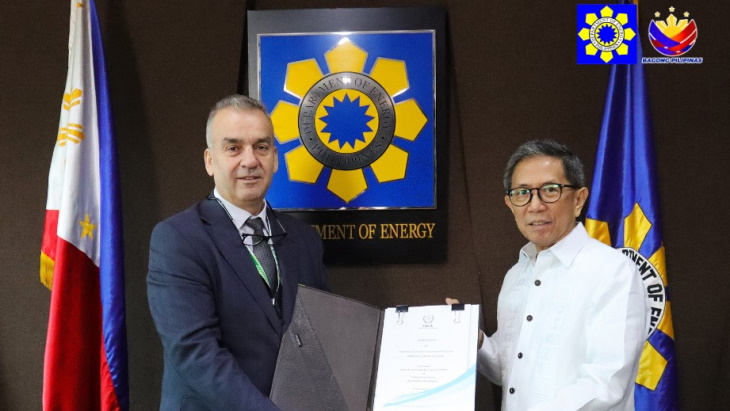
INIR mission team leader Mehmet Ceyhan presents the draft report to Raphael Lotilla, Philippine Secretary of Energy (Image: Philippine Department of Energy)
Integrated Nuclear Infrastructure Review (INIR) missions enable representatives from IAEA member states to have in-depth discussions with international experts about conditions and best international practices in the development of a nuclear power programme. Such missions are based on the IAEA Milestones Approach, with its 19 infrastructure issues, three phases (consider, prepare and construct) and three milestones (decide, contract and commission/operate).
The follow-up INIR mission, conducted at the request of the government of the Philippines, took place from 2-6 December. The mission team assessed progress in addressing the recommendations and suggestions made during the initial INIR mission in 2018 to assist the Philippines in its infrastructure development. It reviewed the status of nuclear infrastructure development using the Phase 1 criteria of the IAEA Milestones Approach. Phase 1 evaluates the readiness of a country to make a knowledgeable commitment to a nuclear power programme.
The follow-up INIR mission team - comprising two international experts from Turkey and Pakistan and two IAEA staff - noted that the Philippines has made significant progress to address most of the recommendations and suggestions and has adopted a national position for a nuclear energy programme.
The mission said the Philippines has drafted and advanced a comprehensive nuclear law towards enactment; completed assessments in human resource development, regulatory framework, radiation protection, radioactive waste management, and emergency preparedness and response; and drafted policies and strategies in the relevant areas.
"The Philippines expanded the composition of its Nuclear Energy Programme Implementing Organisation (NEPIO) to 24 organisations, and all sub-committees of NEPIO are actively engaged to implement relevant activities," said mission team leader Mehmet Ceyhan, Technical Lead in the IAEA Nuclear Infrastructure Development Section. "This indicates the level of commitment of the Philippines to proceed with their nuclear power programme."
The team indicated that further work is needed to finalise the Philippines' nuclear power strategy and to complete necessary studies for future activities related to the electrical grid, industrial involvement and national legislation.
In response to the 1973 oil crisis, the Philippines decided to build the two-unit Bataan plant. Construction of Bataan 1 - a 621 MWe Westinghouse pressurised water reactor - began in 1976 and it was completed in 1984 at a cost of USD460 million. However, due to financial issues and safety concerns related to earthquakes, the plant was never loaded with fuel or operated. The plant has since been maintained. There have been several proposals over the years to either start up the plant or convert it to a gas-fired plant.
In March 2022, then President Rodrigo Duterte signed an executive order that outlined the government's position for the inclusion of nuclear energy in the Philippines' energy mix, taking into account economic, political, social and environmental objectives. The country aims to have its first nuclear power plants operational by 2032, with an initial capacity of 1200 MW, expanding to 2400 MW by 2035 and reaching 4800 MW by 2050.
"The IAEA's recognition of our progress in addressing most of the recommendations and suggestions from the initial 2018 INIR Mission reflects the Philippine government's steadfast commitment to developing a robust nuclear power programme," said Philippine Secretary of Energy Raphael Lotilla.